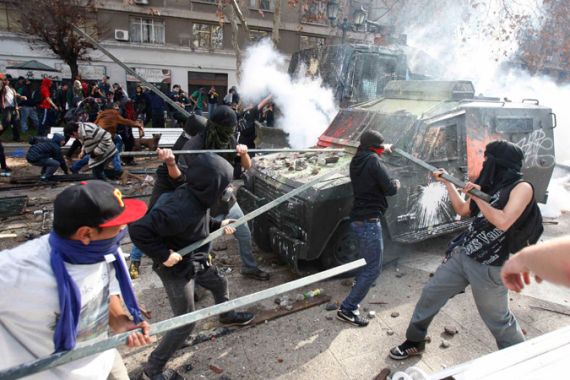Student protests turn violent in Chile
Riot police break up protests after thousands march peacefully in Santiago to demand education reforms.

| Al Jazeera’s Teresa Bo spoke to students from Chile’s Catholic University taking part in the protests |
Chilean riot police fired tear gas and used water cannons to disperse violent protesters on the fringe of an otherwise peaceful student demonstration in the capital Santiago.
Tens of thousands of teachers, students, parents and sympathetic labour activists marched in central Santiago on Tuesday for the fifth time in two months to demand reforms from the conservative government of President Sebastian Pinera.
Keep reading
list of 4 items‘We share with rats’: Neglect, empty promises for S African hostel-dwellers
Thirty years waiting for a house: South Africa’s ‘backyard’ dwellers
Photos: Malnutrition threatens future Afghan generations
The peaceful protest came apart when a group of hooded youths hurled sticks and rocks at riot police near the presidential palace of La Moneda. Some of the youths smashed street lights and broke windows, and a car was set ablaze.
Police said about 60,000 people marched. Organisers put the number closer to 100,000.
“The time has come to fight, not to negotiate,” some students said in their banners.
Demonstrators walked past the Dario Salas School, where three minors have been on hunger strike for 21 days to support student demands.
Chilean student protests started three months ago and have already led to a change of minister.
Last week, close to 900 people were arrested and 90 police officers were injured in student protests.
In recent months, hundreds of thousands of people have poured onto the streets to support the movement, whose rallies have drawn the biggest crowds for protests in Chile since the end of the military dictatorship in 1990.
The student protest has had a significant impact on Pinera’s popularity rating, which sank to 26 per cent according to an opinion poll published last week, the lowest support rating for any Chilean president since 1990.
Students want the state to take over the public school system, where 90 per cent of the country’s 3.5 million students are educated. It is currently run by local authorities, which protesters say results in deep inequalities.
Chile has the highest per capita income of any country in Latin America, but the Andean nation also has the most skewed income disparity in the region.
Students also want more affordable higher education: most Chilean college students take out loans to go to private for-profit universities because public colleges are few and underfunded.
“I’m marching because I have two children and I can’t make ends meet; they are going to be in debt for years” when they go to college, Graciela Hernandez, one of the protesters, told AFP.
“The government is not listening to us, we want a new education system in Chile and the government proposals do not address what we want,” said Manuel Soto, a protester from the University of Santiago.
“The protests will continue … until the government gives us better education,” Soto told AFP.
Police authorised the Tuesday march, unlike a protest last Thursday that resulted in more than 800 arrests.
Protests have been mounting since Pinera, the first right-wing president to govern Chile since the country returned to democracy in 1990, announced wide-ranging education spending cuts earlier in the year.
Protests also occurred in Chile’s other main cities, including Arica, Valparaiso and Concepcion.
Unions representing public workers and copper miners announced they would join the students, a sign that the social upheaval against Pinera, in power since March 2010, is broadening.